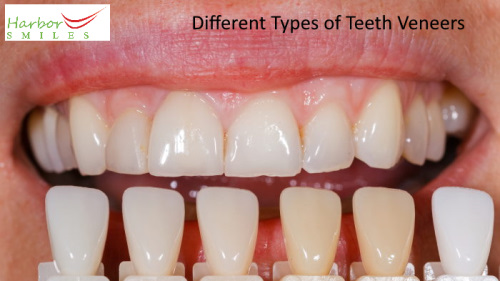 Veneers are thin, custom-made coverings that fit over teeth to improve their appearance and create a beautiful smile. As a result, dental veneers are sometimes referred to as “smile makeovers.” Even though veneers may change a tooth’s shape, size, color, and functionality, they are usually considered cosmetic dental operations.
Veneers are thin, custom-made coverings that fit over teeth to improve their appearance and create a beautiful smile. As a result, dental veneers are sometimes referred to as “smile makeovers.” Even though veneers may change a tooth’s shape, size, color, and functionality, they are usually considered cosmetic dental operations.
There are two main types of veneers in the dentistry industry: porcelain and composite resin. There are several different kinds of veneers available nowadays, though. Your choice of veneer will depend on various criteria, including your budget, degree of comfort, oral health, and more.
Porcelain veneers are thin medical-grade ceramic shells covering the fronts of natural teeth. Porcelain veneers enhance your smile by addressing tooth size and form, spacing concerns, and alignment issues.
Composite veneers, which enhance the look of teeth, are constructed of tooth-colored resin. Composite veneers are used to improve the look of teeth and repair tiny chips or cracks.
Table of Contents
What Are the Different Types of Teeth Veneers?
The dental industry offers both permanent and temporary veneers. The material also affects the durability and aesthetic appeal of the veneers. Because of this, each type of veneer is best suited to certain conditions and requirements.
It’s crucial to consider all potential outcomes while assessing veneer kinds. In the following paragraphs, porcelain, ceramic, composite, Lumineers, zirconium, E-max, snap-on, same-day, and palatal veneers will all be covered.
Porcelain Veneers
You may quickly get porcelain veneers, one of the most popular types of veneers, from a dental clinic nearby. They are constructed of feldspar, a naturally occurring glass ceramic. Feldspathic porcelain is fragile and transparent, giving it a very natural aspect. Another fantastic advantage of porcelain veneers is its incredible resistance to stains, chipping, and discoloration. Additionally, they outlive all other veneer types. When a patient desires permanent teeth that seem natural, are stain-resistant, and last between 8 and 15 years, porcelain veneers can be employed.
| Porcelain Veneers Pros | Porcelain Veneers Cons |
|
|
|
|
|
|
|
|
|
Ceramic Veneers
Ceramic veneers, which are extremely thin, are applied to the teeth in a minimally invasive technique. They repair teeth that are chipped, fractured, or out of place. In addition, dentists can use ceramic veneers to enhance the looks of a single tooth, an existing gap, or even the entire set of teeth. When a patient desires teeth that seem natural but are less expensive and intrusive than porcelain veneers, ceramic veneers may be employed.
| Ceramic Veneers Pros | Ceramic Veneers Cons |
|
|
|
|
|
|
|
Composite Veneers
Composite veneers can be utilized as an alternative to porcelain veneers since they can be produced more rapidly and inexpensively. The majority of composite veneers are made of resin, a material that is tooth-colored and utilized for dental restoration. They are more successful when used on the front teeth because of the fragility of the posterior teeth. Composite veneers are more prone to stains, abrasions, and cracks than porcelain veneers and have a shorter lifetime. Composite veneers may be employed when a patient desires a rapid, temporary surgery that is also reasonably priced.
| Composite Veneers Pros | Composite Veneers Cons |
|
|
|
|
|
|
|
Lumineers
Lumineers are one-visit veneer treatments with little tooth preparation, sometimes known as “no-prep” veneers. Small, compact shells are gently attached to the teeth to replace the worn-out surface. For teeth that are cracked, misshapen, or discolored, Lumineers are viewed as a temporary fix. Lumineers are fabulous for folks who want veneers but would rather avoid intrusive procedures. To know if this is for you, you can compare Lumineers vs porcelain veneers.
| Lumineers Pros | Lumineers Cons |
|
|
|
|
|
|
|
Zirconium Veneers
The best dental procedure for treating dental issues such as severe decay, chipped teeth, and broken teeth are zirconium veneers, one of the most resilient veneer materials. They provide an answer to the discoloration problem because of their opaque nature. Due to their superior strength and quality, they frequently outlive the bulk of other veneer varieties. Therefore, Zirconium veneers are an option for patients who need stronger teeth owing to dental decay, damaged teeth, or clenching or grinding (bruxism).
| Zirconium Veneers Pros | Zirconium Veneers Cons |
|
|
|
|
|
|
|
|
|
E-Max Veneers
Lithium disilicate glass-ceramic is the material used to make E-max veneers, one of the most popular types of veneers. Because of their innate beauty, durability, and lifespan, E-max veneers are among the best available today. Because of their transparency, they might appear to be your real teeth. E-max veneers can be utilized when a patient desires teeth that seem natural, endure a very long period, and are resistant to staining.
| E-max Veneers Pros | E-max Veneers Cons |
|
|
|
|
|
|
|
|
Snap-on Veneers
Snap-on veneers, sometimes referred to as clip-on veneers, are removable, so the appearance of the natural teeth is not altered. The best alternatives to dental implants are traditional porcelain veneers and clear braces. These temporary veneers require less invasive approaches than conventional dental operations. In other words, they don’t require uncomfortable and intrusive procedures like tooth scraping to apply. When a patient desires detachable, cheap veneers that need to be applied quickly, snap-on veneers might be employed.
| Snap-on Veneers Pros | Snap-on Veneers Cons |
|
|
|
|
|
Same-Day Veneers
Since they are designed, created, and put all on the same day, same-day veneers are sometimes referred to as ready-made veneers. In contrast to traditional porcelain veneers, they are made in a dental clinic using a milling machine using CAD/CAM technology. The process involves cleaning the teeth, scanning them digitally, and creating veneers. When a patient desires rapid and reasonably priced veneers, same-day veneers can be employed. To know if this is for you, compare same day veneers vs traditional veneers.
| Same-Day Veneers Pros | Same-Day Veneers Cons |
|
|
|
Palatal Veneers
Palatal onlays and lingual veneers are two terms used to describe palatal veneers. These specifically created teeth veneers were created to restore anterior teeth that have suffered damage from tooth decay or other comparable problems. Palate veneers are rare veneers because patients usually neglect this problem. Patients who wish to fix the back of their teeth might utilize palatal veneers.
| Palatal Veneers Pros | Palatal Veneers Cons |
|
|
|
|
|
|
|
|
|
A research that was written up in the Journal of Dentistry investigated and studied two different kinds of veneers over 2.5 years to see which had a higher survival rate. The types of veneers used in this study were porcelain veneers vs composite veneers. Because porcelain veneers continue to be the best on the market, the study’s findings indicated they had the best overall survival rate.
How Do You Choose the Right Type of Dental Veneer for You?
Selecting the proper dental veneer might be challenging, but a straightforward breakdown can guide you based on cost, adaptability, and veneer type.
Cost
Porcelain is the most popular type of veneer because of its natural look and stain resistance. However, they are also the most expensive sort of veneer. If money is a concern, composite veneers can be a better option. Composite veneers are less enduring than porcelain veneers while being more inexpensive. Remember that since veneers are considered a cosmetic procedure, insurance frequently does not cover the cost of obtaining them.
Versatility
Because porcelain veneers come in a range of colors, you may choose the one that most nearly mimics the color of your original teeth. Although there aren’t as many colors available for composite veneers, you might be able to get the hue personalized to match your natural teeth.
Type of veneer
What kind of veneer should be utilized depends on the type of tooth that needs one. A typical porcelain dental veneer is the best solution for a molar. When you have an exposed tooth close to the front of your mouth, you might choose a Lumineers dental veneer. Both veneers are highly durable and long-lasting since they are made of porcelain. They are both equally gorgeous and have lovely smiles.
What Are the Best Snap-On Veneers?
Shiny Smile is now the best option for snap-on veneers. Because they provide one of the most attractive pricing points on the market, you may have a set of well-fitting, natural-looking veneers without spending a fortune.
Do Composite Veneers Ruin Your Teeth?
No, using composite veneers is a very dependable and secure process. They can cover stained or fractured teeth while preserving the tooth’s natural structure. All you have to do is brush and floss your teeth correctly each day.
What Is the Difference Between Composite Bonding and Composite Veneers?
In contrast to composite veneers, which are made by removing some enamel and coating the whole front surface of the tooth in composite resin, composite bonding involves the dentist creating structure and shape for a tiny region of a tooth using composite resin.
There are different types of veneers. To find the one that suits your needs and budget, contact Dr. Manali Patel at Harbor Smiles.

